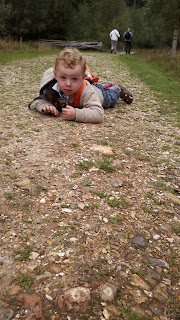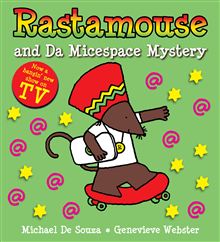Today we found the answer while wandering around Merriments Garden in East Sussex - I can't resist calling it Bugginham Palace, I'm very sorry. Here is a sculptural take on the bug hotel that I think would not just look good, but would also be fantastic fun to build with Lego obsessed children.
 The structure was constructed from reclaimed materials (modern jargon for 'rubbish') including concrete blocks, paving slabs, clay drainage pipes and chopped up bamboo canes, plus a couple of purpose built wooden bug boxes. The actual effectiveness of this design is probably not as helpful to bugs as the more familiar rough stack due to the large gaps between and within the elements - any minibeast trying to shelter in some of the more open tubes would get cold, dry out or find itself snaffled up by a bird or mouse (although web building spider would appreciate the gaps). It could however be easily improved by adding more packing materials such as twigs and leaves and perhaps being used as an attractive fascia to a more traditional log pile which would also help to reduce drafts blowing through the structure.
The structure was constructed from reclaimed materials (modern jargon for 'rubbish') including concrete blocks, paving slabs, clay drainage pipes and chopped up bamboo canes, plus a couple of purpose built wooden bug boxes. The actual effectiveness of this design is probably not as helpful to bugs as the more familiar rough stack due to the large gaps between and within the elements - any minibeast trying to shelter in some of the more open tubes would get cold, dry out or find itself snaffled up by a bird or mouse (although web building spider would appreciate the gaps). It could however be easily improved by adding more packing materials such as twigs and leaves and perhaps being used as an attractive fascia to a more traditional log pile which would also help to reduce drafts blowing through the structure.If you have a little (or a large) space that you want to turn into a bug hotel (or palace) you can produce a really fun and informative series of activities.
1) Go on a bug hunt and try to get your children to describe what the places they found the bugs were like - it's a good activity to build on children's observational skills and use of descriptive language, and will help to inform the next step. You could also start to discuss why the creatures like the places they were found in - for example woodlice and pillbugs are the only land dwelling form of their kind - all the other arthropods live in water (e.g. sea slaters) - woodlice have very poor ability to retain water and regulate body temperature, and therefore tend to shelter together in damp places such as under piles of rotting leaves.
2) Design your bug hotel. Get your kids to do this verbally, or through drawings, or a collage. You can guide them with ideas about what materials you can use - what will you be able to forage or find? How are you going to put them together? You may want to add in a foraging/gleaning step before this if you're not sure what materials you'll be able to get hold of. If you're kids are small, plan small too - the last thing you want is a tall 5 pallet bug house collapsing on them when they inevitable pull it to pieces to see who has taken up residence. This is a good opportunity to talk about food chains - who are your intended guests going to be hiding from or eating?
3) Gather your materials. Wood that is treated will be useful for building the structure (e.g. pallets, old fence posts and panels) but since it is likely to have been pressure treated with cyanide it will rot slowly and not be as useful a food source as untreated wood. Likewise for stone, clay pots and pipes, flagstones etc... Pack these materials will items that will provide small hidey holes, such as sections of bamboo canes which will provide homes for overwintering lacewings (useful for munching aphids) and all year round for solitary bees. Other useful packing materials include leaves that will rot fairly slowly (a year or so to turn into leafmould depending on how damp they are) and will provide food and shelter for woodlice and millipedes, and their predators. Sticks of all sorts are a useful addition, but especially those from deciduous species (those that drop their leaves in the Autumn) since evergreens such as pines have a different carbon to nitrogen ratio that means they rot slower and they may also contain resins that slow decay and make them unappealing foodstuffs (think how a pine forest floor is covered in pine needles, while an oak woodland is crumbly brown earth).
4) Build your bug hotel. Where you put it is going to depend on your available space and how prominent a feature you want it to be, but as a rule of thumb damp, shady areas will attract a different mixture of species to dry, sunny spots. For example, siting your hotel near a pond may result in a fat crop of slugs, their predators and possibly even a toad (also a slug predator). A warm, sunny spot may be attractive to solitary bees, spiders and overwintering butterflies.
Cautions:
Make sure you instill handwashing as a routine after bug hunting since there are parasites and pathogens associated with some minibeasts, such as lungworm in slugs. I find it worth thoroughly checking over our intended area for cat mess before we start digging around. Avoid any areas that are obviously soiled by bird droppings.
If you live in a region with potentially risky species such as vipers which may take up residence, follow the guidelines issued by your local wildlife authorities. Even here in the UK there are areas with populations of Adders which have a painful bite that requires immediate medical treatment. I personally avoid handling centipedes too as they have a hefty bite, even if UK species are not life threatening. Several beetles can bite, as can ants and some spiders, so I find a little plastic scoop and a small bucket or ice cream tub are useful for bug hunting.
If you build a log pile, don't let your kids walk or climb over it as logs can roll suddenly, trapping fingers or worse.
Be aware that some species are protected, so if you find them living in your hotel you mustn't handle them. Slow worms were my favourite species to find when minibeast hunting while I worked as a Fieldstudies Instructor, but these harmless legless lizards are protected and you should avoid handling them. Again, follow whatever your local wildlife authority's advice is on this.







.jpg)












